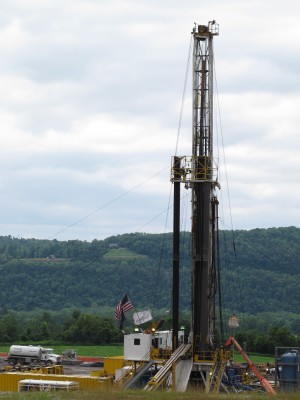Study: Lower than expected air pollutants detected at Marcellus drilling sites
An article in the journal Environmental Science and Technology, published today, says measurements of air pollution from Marcellus drilling and transportation sites in Bradford and Sullivan counties were lower than the researchers expected. The study, “Atmosphere Emission Characterization of Marcellus Shale Natural Gas Development Sites,” also reports levels of methane emissions were higher than those indicated in previous research.
Peter DeCarlo is assistant professor in the civil, architecture and engineering department at Drexel University and lead researcher on the report.
“We had seen a lot of data from other natural gas or oil development areas and we had seen pretty high levels of pollutants,” said DeCarlo. “So we went in expecting to see similar things in the Marcellus. The geology in the region is different in that [it produces] a lot of natural gas but we didn’t see a lot of the air quality pollutants that we expected.”
The researchers used a more sophisticated measuring technique than is typically available to researchers or regulators such as those at the Department of Environmental Protection. The researchers used tracers to track the plume of emissions in order to measure levels of carbon monoxide, carbon dioxide, nitrous oxides, sulfur dioxide and particulate matter.
“We did very fast measurements over large spacial areas and downwind of the gas sites,” said DeCarlo.
DeCarlo says it’s a much more expensive technique, but more effective than ambient air quality measurements, which can be impacted by weather and wind speed.
The study looked at 17 separate measurements from 13 different facilities in the summer of 2012, which DeCarlo admits is a small sample size given the prevalence of drilling in Pennsylvania’s Marcellus Shale. Industry did not grant access to the sites, so the measurements were made at the fence line.
DeCarlo says although they did not detect high levels of air pollutants, gas production has had an impact in rural areas.
“Yes, it’s impacting it in that the pre-drilling air quality was better,” said DeCarlo. “It’s less clean now, but [the air is] still going to be better than [air quality] in a major metropolitan area.”
One aspect of diminished air quality that was detected at compressor stations included higher levels of ultra-fine particles.
“It’s not surprising that we saw those,” said DeCarlo. “The question is are those going to impact health. That’s still getting debated in scientific literature.”
Albert Presto, a researcher and assistant professor at the Center for Atmospheric Particle Studies at Carnegie Mellon University, who was not involved in the study, says the report adds to a growing body of work on emissions from natural gas production in the Marcellus Shale. Presto is conducting his own research into emissions from Marcellus Shale sites.

















